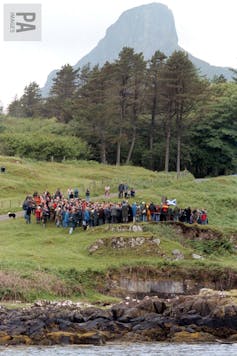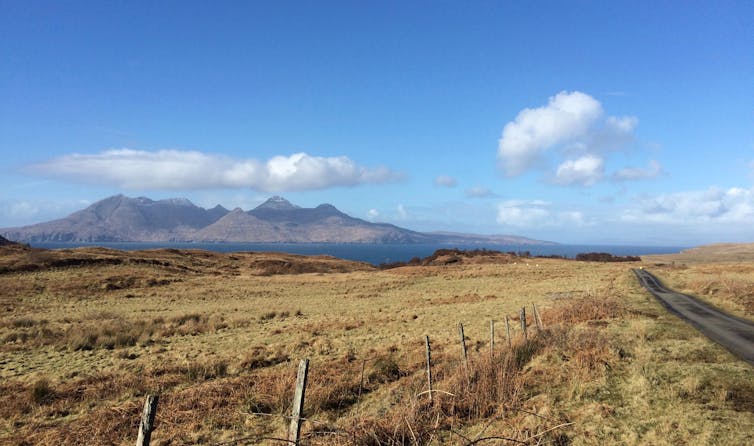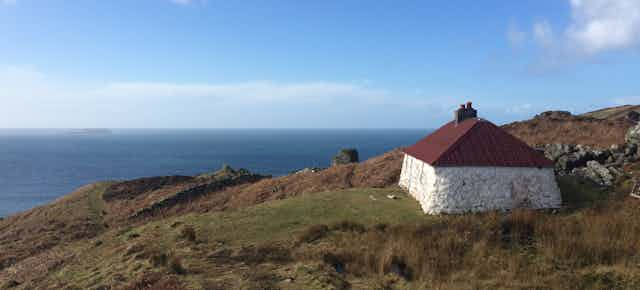One of the Small Isles of the Inner Hebrides off the north-west coast of Scotland, Eigg is a place of history, flora and fauna and home to a vibrant community of 100. Changeable weather aside – although this too is part of its charm – it is an idyllic setting, offering all the benefits of island life.
But in 1997 the population had declined to 65 and islanders had suffered for decades with absentee landlords, where security of tenure was denied to all but a few and investment in homes and businesses was at the whim of the owner. This was before land reform was introduced to allow those who lived in such places some democratic control over their lives.
As pioneers of a movement across the Highlands and Islands, in April 1997 a bid for the island by the Isle of Eigg Heritage Trust, a partnership between the residents of Eigg, the Highland Council and the Scottish Wildlife Trust, was accepted by its enigmatic German owner, an artist by the name of Maruma. The people had “won the land” to echo the similar struggle of the people of Assynt in Sutherland in 1992.
In Scotland, if communities can raise the funds to meet the market price, they have first option to buy their land when it comes up for sale; in the crofting counties this is a right which can be exercised at any time, which essentially means a forced sale. To attract public sector support, there must be a community body registered to manage the process.

The Eigg community buy-out was funded by public and private donations from across the globe. Since then, the Heritage Trust has been managing the island on behalf of the community, assuming responsibility for stewardship of the island, its buildings and natural heritage, and for promoting economic and social development.
Some of the essentials of modern living had been denied to people on Eigg – especially energy. From reliance on domestic diesel generators and coal for very restricted heat and light, the Trust has established its own renewable electricity supply by establishing a local grid run by Eigg Electric. Washing machines, TV and other modern appliances can now be operated, within limits of 5kw per household – which represents a big improvement on the past. A fast broadband connection is available too.
Locals run and maintain the grid, the wind turbines, mini-hydros and the bank of solar panels – and they continue to explore local solutions and training opportunities. Eigg Trading, a subsidiary of the Isle of Eigg Heritage Trust, leases the pier centre – An Laimhrig – to the local store, tearoom/bar and craft shop.
New housing, glamping and eco pods, a brewery and bothy project (revamping old estate worker dwellings) are all examples of how the community is evolving in ways that contrast starkly with the neglect of previous landlords. The forces of the lords and lairds, who cleared and then impoverished such communities of rural Scotland, have been progressively tamed by the efforts of Eigg, Assynt and others in remote and fragile places.
In March, after a short fieldwork trip to Eigg, I found myself stormbound for three days. Ferries only land every other day, so this enforced delay confirmed how vulnerable and yet resilient such communities are. That the people of Eigg can take such disruption in their stride is testimony to islanders’ resilience generally, but it also demonstrated the capacity to accommodate visitors, to ensure those living alone were kept warm, fed and well.
After the storm, the natural beauty of this Hebridean island – dominated by An Sgùrr, a magnficent, lofty hunk of rock circled by sea eagles and a prime place to spot whales and dolphins – complemented the discussions in the eco-centre and at the ceilidh in the café.

What was revealed was the rich human capital, the resourcefulness of the people of Eigg and the way in which the residents led by the Trust have grown into managing and developing this community. Work and incomes are critical to the survival of such communities, yet the islanders voted against a fish farm development in line with their Green Eigg eco-commitment.
Saltires, CND flags and anti-nuclear banners are noticeable here – this is an island that pursues an environmentally sustainable approach to life, that voted for independence and to remain in the European Union. Without the heavy weight of the landlord destroying enterprise, activity and vitality, a very different future has become possible on Eigg. While external support and funds have been important in their island’s revival, it is the islanders’ own energy and vision that have turned this place around.
An island on the edge, on the periphery of the continent, Eigg considers itself as part of a movement of thinking globally and acting locally. This is an island of immigration and inclusion – not an insular community, but one connected to the wider world. Recently, representatives of the unions for the landless of Brazil came to Eigg to discuss building community resilience through renewable energy projects – and islanders have hosted and visited other communities from across Scotland, Europe and beyond to share knowledge.
Eigg, Gigha, Assynt and other community buy-outs have demonstrated what “ordinary” people can do, given the chance. Like the working lighthouse operated by the Isle of Eigg Heritage Trust, the community here stands as a beacon for people seeking reversal of decline across Scotland and in disempowered communities around the globe.

